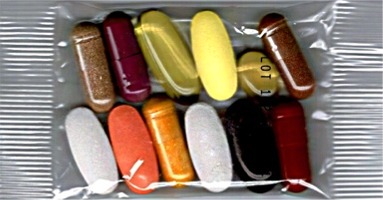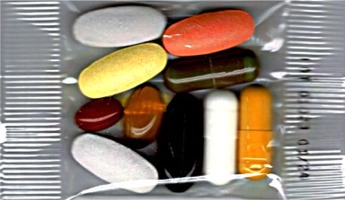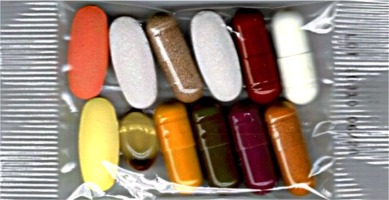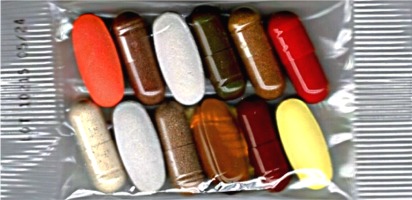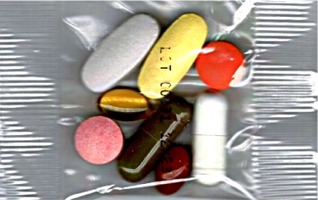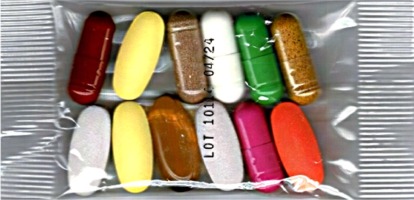- Beta Carotene: In the last few
years increasing numbers of reports have suggested that the use of Beta
Carotene may act to prevent the development of various malignancies. Beta
Carotene and other similar compounds have differentiating properties that
appear to affect cell growth and maturation. Beta Carotene is not toxic to
the liver even in high doses in contrast to Vitamin A. Large doses of Beta
Carotene will increase the body's demands for Vitamin E; therefore, those of
you on 50,000 to 100,000 units of beta carotene per day will need to also
increase your vitamin E to 1,000 to 2,000 units per day. The definitive role
of beta carotene/vitamin E is yet to be understood, but there is sufficient
reason to use beta carotene in a dose of 50,000 units per day. There is no
need to supplement this with carrot juice or vitamin A. Beta carotene, like
vitamin A and E is stored in the liver. Current clinical trials in
prevention of cervix cancer and cancer of the lung and breast are using beta
carotene. This may also be helpful in the prevention of colon cancer and
melanoma.
ANR Formula One, Two,
Three, Four, Five,
Six, Seven
Heart,
Alert, Maximus, CATALOG
- VITAMIN E: Please read the
above. Vitamin E is an important anti-oxidant. It acts as a free radical
scavenger to prevent the byproducts of chemical-cell interaction to cause
cell damage. Free radicals are likely responsible for all or most of the
degenerative diseases e.g. arthritis, heart disease, cancer, senility etc.
The absorption or scavenging of free radicals would protect our cells from
this type of injury. Other free radical scavengers include zinc, vitamin C,
and selenium.
Studies have reported vitamin E to protect against some of the toxicities of
ionizing radiation. Vitamin E may help to decrease the toxicity of certain
chemotherapy drugs. Adriamycin is an important anti-cancer drug with
potential major toxicity to the heart. The use of 1000 to 2,000 units of
vitamin E per day may help to decrease this toxicity. Vitamin E may decrease
some of the harmful effects of solar radiation on the skin. As cited above
it works well in conjunction with beta carotene. Vitamin E appears to have
stabilizing effect on the vascular system and is useful in decreasing
menopausal and premenstrual symptoms. It is useful in decreasing leg cramps
occurring especially at night. Vitamin E can be used in lotions or creams to
protect the skin or to treat for burns. It is also helpful to treat burns
secondary to radiation therapy. I have also used it with good results in
patients with dermatitis resulting from poor blood circulation i.e. stasis
dermatitis. It is commonly prescribed for topical use in pregnant women to
prevent stretch marks on the abdomen. More recently it has been used to
prevent or treat mucositis resulting from chemotherapy. I advise patients to
bite into a 1000 unit capsule and swish the vitamin E around the mouth and
over the mucous membranes lining the cheeks. This is done three to four
times a day. You can also use liquid vitamin E to do this.
ANR Formula One, Two,
Three, Four, Five,
Six, Seven
Heart,
Alert, Maximus, CATALOG
- B COMPLEX: The B complexes are
important membrane stabilizers. They are natural tranquilizers or
anti-stress vitamins because of this property. They are important vitamins
to help nerve function. The B complex vitamins contain PABA which is
important in protecting the skin against the harmful effects of Ultra-violet
radiation. PABA is an excellent UV screening agent and helps to protect
against the development of skin cancer or sun-induced skin damage e.g.
wrinkling and solar keratoses. Fair complexioned people should avoid sun
exposure and should use sun- blockers with at least a 15 factor as well as
use B complex orally. Such people are actinic or sun sensitive and are at a
greater risk for the development of skin cancers of all types. People with
red hair, blue or green eyes tend to be sun sensitive (actinic sensitive).
Women using oral contraceptives increase their utilization of the B vitamins
and need to supplement their diet with B complex. Patient under high stress
should do the same. The B vitamins are water soluble. They are not stored in
the body as are beta carotene and vitamin E. B complex must be taken with
food already in the stomach. If taken on an empty stomach, pain and nausea
are not uncommon. The use of B complex in a dose of 100 mg once to three
times a day with meals is recommended per patient tolerance. If the B
complex is being absorbed the urine will be bright yellow and have a pungent
smell due to the riboflavonoids present. This is to be expected and should
not cause alarm. If no change in urine color is noted then suspect that your
brand of B complex is not being absorbed by your body- change brands.
ANR Formula One, Two,
Three, Four, Five,
Six, Seven
Heart,
Alert, Maximus, CATALOG
- VITAMIN C: This vitamin is
important for tissue healing. Patients with peptic ulcers will heal faster
on vitamin C than those without extra vitamin C. As mentioned previously,
vitamin C is an anti-oxidant. It is also water soluble as B complex. I
advise that it be used in doses of 2,000 to 6,000 mg after each meal to take
advantage of its anti-oxidant effects. I would start with 1,000 mg after
each meal and increase slowly up to 6,000 mg after each meal. Side-effects
of large doses include diarrhea and flatulence. Studies in Canada show a
decrease number of colon polyps in patients taking high doses of vitamin C.
Such polyps are precursors for colon cancer. If we can decrease polyp
formation with vitamin C perhaps we can decrease colon cancer as well. The
use of vitamin C in this capacity should accompany a very low fat diet that
is high in dietary fiber. Smoking and alcohol consumption will increase the
excretion of vitamin C. Alcohol will actually deplete all of the water
soluble vitamins. Vitamin C has been touted by Pauling and Cameron to
decrease cancer growth and cause remissions in cancer patients. I have not
seen any evidence in all of the studies published to warrant that
conclusion. The studies published by Pauling and Cameron were scientifically
unsound and poorly controlled. Major trials using high dose I.V. vitamin C
fail to confirm any anti- cancer effect of this vitamin in patients with
established cancer.
High dose vitamin C may be a problem in patients with a tendency to kidney
stone formation. Check with your physician if this is your situation.
In patients receiving iron supplements to help treat iron deficiency, the
use of vitamin C taken at the same time as the iron medicine will greatly
enhance the absorption of iron. Vitamin C will help with wound healing and
healing of burns. It improves the strength of the walls of the blood vessels
and may help decrease the easy bruising seen with some patients. Vitamin C
in topical form to prevent sunburn and to absorb the ultraviolet rays will
soon be available.
Vitamin C may help people with low back pain and arthritis due to its anti-
oxidant effects. This and other vitamins need to be taken over long periods
of time. These substances work over time -- be patient.
ANR Formula One, Two,
Three, Four, Five,
Six, Seven
Heart,
Alert, Maximus, CATALOG
- SELENIUM: This is an
anti-oxidant with activity as a free radical scavenger. Populations with
high blood selenium levels are found to have lower death rates due to
cancer. Mormons have high selenium blood levels perhaps related to their
diet. Cancer patients have low selenium blood levels. Selenium works in
harmony with vitamin E. Selenium toxicity can occur and the dose of selenium
should be close to 100 MICROGRAMS (not milligrams) per day.
ANR Formula One, Two,
Three, Four, Five,
Six, Seven
Heart,
Alert, Maximus, CATALOG
- CALCIUM-MAGNESIUM: Calcium is
deficient in most of our diets. This deficiency is most prevalent in women
who have had children and have never supplemented their own diets with
calcium. Calcium consumption along with exercise is the best means to
prevent calcium deficiency. Once calcium is lost and signs of osteopenia
develop the medical problem may be hard to reverse. Collapse of bone and
fractures commonly of the pelvis may occur in such individuals. When people
"shrink" with age it is due to vertebral compression fractures
caused by osteopenia, commonly referred to as osteoporosis. Bone density
studies will detect patients having osteopenia. Calcium, like B complex acts
as a membrane stabilizer and natural tranquilizer as does magnesium and
potassium. Calcium and magnesium should be taken together in a ratio of 2:1.
A daily intake of Calcium of 1,000 to 1,500 mg is reasonable.
Calcium/magnesium may be taken at bedtime to promote sleep. Magnesium in the
form of magnesium oxide in combination with vitamin B-6 has been shown to
dissolve certain types of kidney stones (calcium oxalate stones). This
preparation is called Beelith and is taken twice a day. It is also helpful
in patients with chronic constipation since magnesium salts act as
cathartics. During pregnancy the intake of calcium and magnesium should be
increased to prevent deficiency in mother and child. Patients with potassium
deficiency should always be checked for magnesium deficiency. In the
presence of magnesium depletion, it is very difficult to replete potassium
stores. I have used a calcium citrate source containing vitamin D to enhance
calcium absorption. This is an effervescent formulation and it is taken as
two tablets dissolved in a glass of cold water per day. Calcium citrate is
better absorbed and utilized than calcium carbonate. The use of fluoride in
a liquid formulation (potassium fluoride 180 mg/cc) help bind calcium in the
bones. Fluoride drops are taken as 1 drop in juice or water three times per
day. This is a prescription item and must be made up by the pharmacist. The
dose can be slowly increased per the physician. Fluoride in this
concentration can irritate the gastric lining. Slow increases in dose are
important to prevent this side-effect.
ANR Formula One, Two,
Three, Four, Five,
Six, Seven
Heart,
Alert, Maximus, CATALOG
- ZINC: This element is
important in wound healing. It also functions as an anti- oxidant. It is
helpful in the treatment of acne. It hastens healing of peptic ulcer disease
and burns. The recommended dose is 100 mg per day. Chelated zinc will not
cause the gastrointestinal distress the inorganic zinc will. Therefore,
request a chelated zinc rather than zinc sulfate.
ANR Formula One, Two,
Three, Four, Five,
Six, Seven
Heart,
Alert, Maximus, CATALOG
Please note that the recommendations made here are based on
medical reports and on personal observations. Many of these reports are viewed
with skepticism by members of the medical profession. If you review the
recommendations made in the 1981 handout you will note that at that time most
of the suggestions regarding dietary modifications and vitamins and trace
elements would be laughed at. Today, many if not all, of these suggestions are
considered good medicine.
Stephen B. Strum M.D.
September 1994
ANR Formula One, Two,
Three, Four, Five,
Six, Seven
Heart,
Alert, Maximus, CATALOG
Also see:
Phytochemicals: Nutrients Of
The Future
Antioxidants: An Antidote to
Aging?
Better Eating for Better Aging
Nutrition Is Key To Successful
Aging: Kidd
Latest Concepts in Nutrition
Life Long Weight Management
for Health & Happiness
10 Tips to Healthy Eating
New Perspectives on Diet and
Cancer
Upbeat on Fiber for Longer
Life & Better Health
A Refresher On Water for Long
Life & Health
Reference Guide for Vitamins
Reference Guide for Minerals
Reference Guide for Herbs
Reference Guide for Amino
Acids
Reference Guide for Special
Nutrients
Reference Guide for
Anti-Oxidants
Reference Guide for Nutritional
Greens
Reference Guide for Digestive
Nutrients
Reference Guide for Dietary
Fibers
Suggested Readings and Guide
References
ANR Formula One, Two,
Three, Four, Five,
Six, Seven
Heart,
Alert, Maximus, CATALOG
|
